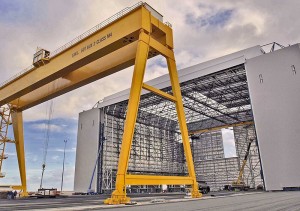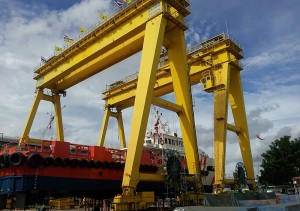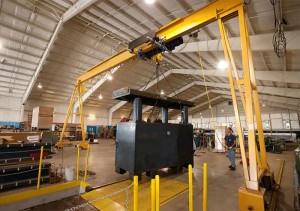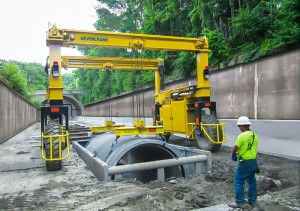
China Manufacturer Boat Gantry Crane Hot Sale
Components and Working Principle
A boat gantry crane, also known as a marine gantry crane or a ship-to-shore crane, is a specialized type of crane used in ports or shipyards to lift and move heavy loads, such as boats or containers, between the shore and ships. It consists of several key components and operates on a specific working principle. Here are the main components and working principle of a boat gantry crane:
Gantry Structure: The gantry structure is the main framework of the crane, typically made of steel. It consists of horizontal beams supported by vertical legs or columns. The structure is designed to provide stability and support the other components of the crane.
Trolley: The trolley is a movable platform that runs along the horizontal beams of the gantry structure. It is equipped with a hoisting mechanism and can move horizontally to position the load precisely.
Hoisting Mechanism: The hoisting mechanism consists of a drum, wire ropes, and a hook or lifting attachment. The drum is driven by an electric motor and contains the wire ropes. The hook or lifting attachment is connected to the wire ropes and used to lift and lower the load.
Spreader Beam: The spreader beam is a structural component that connects to the hook or lifting attachment and helps distribute the load evenly. It is designed to accommodate different types and sizes of loads, such as boats or containers.
Drive System: The drive system includes electric motors, gears, and brakes that provide the necessary power and control to move the gantry crane. It allows the crane to traverse along the gantry structure and position the trolley precisely.
Features
High Lifting Capacity: Boat gantry cranes are built to handle heavy loads and have a high lifting capacity. They are capable of lifting and moving boats, containers, and other heavy objects weighing several tons.
Sturdy Construction: These cranes are constructed with robust materials such as steel to ensure strength, stability, and durability. The gantry structure and components are designed to withstand the harsh marine environment, including exposure to saltwater, wind, and other corrosive elements.
Weather Resistance: Boat gantry cranes are equipped with weather-resistant features to withstand adverse weather conditions. This includes protection against rain, wind, and extreme temperatures, ensuring reliable operation in various climates.
Mobility: Many boat gantry cranes are designed to be mobile, allowing them to be easily moved and positioned along the waterfront or in different areas of a shipyard. They may have wheels or tracks for mobility, enabling flexibility in handling different-sized vessels or loads.







After-Sale Service and Maintenance
Manufacturer Support: It is beneficial to choose a reputable manufacturer or supplier that offers comprehensive after-sale support. This includes assistance with installation, commissioning, training, and ongoing technical support.
Service Contracts: Consider entering into a service contract with the crane manufacturer or a certified service provider. Service contracts typically outline the scope of regular maintenance, response times for repairs, and other support services. They can help ensure timely and efficient maintenance and minimize downtime.
Regular Inspections: Conduct regular inspections of the gantry crane to identify any potential issues or worn-out components. Inspections should cover critical components such as the gantry structure, hoisting mechanism, wire ropes, electrical systems, and safety features. Follow the manufacturer’s recommended inspection schedule and guidelines.
















